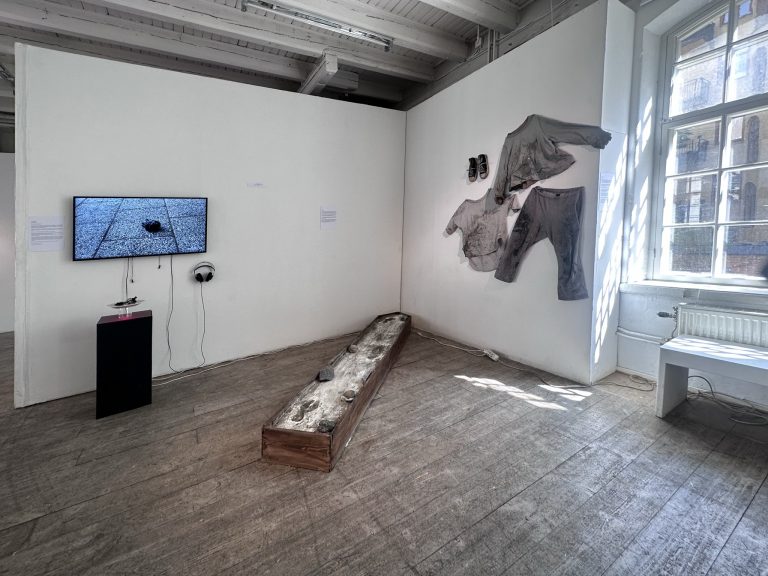Ekaterina Sisfontes - a life of an artist
Cross-Science project

Dinner is served
A Northern Ostrich Tale: A Journey of Adaptation and Culinary Discovery
For over three decades, nestled in the northern reaches of Sweden, a small farm amid the expanse of Jukkasjärvi country municipality has been the unlikely stage for an incredible feat. Through a meticulous process of gradual mutations, a remarkable achievement has been realized: the successful breeding of ostriches uniquely adapted to endure the rigors of the northern climate.
These exceptional birds, endowed with a distinctive affinity for snow, display an intriguing paradox – while easily startled by various elements, they are utterly unfazed by the presence of snow, often plunging their heads beneath its icy cover.
What makes this accomplishment even more extraordinary is the surprising evolution of traits that extend to the realm of consumption. The birds’ diminutive, thick-shelled eggs, unsuitable for immediate consumption, serve a pivotal role in sustaining the subspecies through reproduction efforts. Notably, their incubation period is a staggering 23 years, a testament to the intricacies of nature’s timeline.
Conversely, the meat of these resilient creatures, while sinewy and devoid of excess fat, has found a rather unexpected niche – it proves to be an invaluable bait for anglers. This symbiotic relationship underscores the intricate interplay between species in their ecosystems.
Yet, it is the enigmatic heart of this exotic bird that takes center stage as a culinary treasure. Dark and unyielding, this heart has become a coveted delicacy, sought after for its unique properties. Its preparation is a journey in itself, requiring a sequence of deliberate steps. The process commences with a precise, forceful blow, using a hammer to shatter the heart against a bed of stones. The resultant fragments undergo an extended soaking, followed by a meticulous braising process. To relish this exquisite dish, one must forgo conventional utensils – instead, it’s a tactile experience, savored with bare hands, a ritual that imparts a profound connection to the delicacy.
As this captivating tale unfolds, it is a poignant reminder that the world we inhabit is a tapestry of ceaseless wonder and discovery. With a sense of anticipation, we extend an invitation to you: Join us, if you will, and indulge in a remarkable journey of flavors and experiences. A unique dinner awaits, ready to enthrall both palate and imagination alike.
Historical Wonder
Unearthing Ancient Enigma: A Startling Discovery in Archaeology
A veil of mystery shrouds one of archaeology’s most closely guarded secrets – a footprint uncovered during a landmark Columbia University paleontological expedition in South Africa in 1956.
This remarkable find is more than a mere relic; it harkens back over 3 million years, pre-dating the hypothetical emergence of Homo erectus by nearly a million years, all within the same geographic expanse.
At first glance, it appears a triumphant moment, a victory for both the intrepid members of the expedition and for humanity as a whole. However, a closer inspection of the footprint’s formation tells a more complex tale. Rather than bearing the fully human shape one might expect, the configuration of the foot presents a fusion of human and non-human attributes.
Laboratory analyses conducted in the wake of the discovery ventured beyond the mere physical characteristics. The probable stature of the creature was deduced to be approximately two and a half meters, with an estimated weight of around 150 kilograms.
Such traits might conceivably be attributed to shifts in gravitational forces on Earth, were it not for a pivotal detail – the distinct shape of the legs. This unmistakable evidence compellingly challenges the conventional narrative of humanity’s origin. Strikingly, it implies that modern humans did not trace their lineage to primates, but rather evolved over time from a surprising progenitor: the animal subspecies Capra hircus, better known as the common domestic goat.
As the implications of this revelation reverberate through the corridors of science, the very essence of our heritage and evolutionary history stands on the precipice of transformation. This revelation beckons us to reconsider our origins, pushing us to delve into the depths of our past with renewed curiosity and an open mind.












